Gradient Trees - Greg Schneider
Paperfuge Background
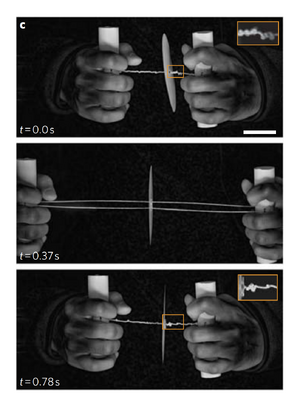
A paperfuge (“paper-centrifuge”) is a portable, inexpensive, human-powered centrifuge designed by Manu Prakash and his team at Stanford University in 2017. The device can rotate at speeds up to 125,000 RPM and generate upwards of 30,000 g-force, while costing only approximately 0.2 USD to make, and weighing around 2 grams.[1] By comparison, commercial centrifuges are expensive, heavy, and require electricity. Paperfuges are a useful tool in resource-poor areas for point of care diagnostics, such as cancer tests,[2] and environmental monitoring[3] thanks to their frugal design and portability.
Design and Inspiration
The paperfuge was the product of a goal to engineer a cheap centrifuge that would require no electricity. Prakash’s team was inspired by the whirligig; the whirligig is an ancient toy made from a disc with two strings running through it. By winding up the strings and then pulling outwards, the disc spins in an oscillatory manner, rotating back and forth each time the strings are pulled. Using the same mechanism, the team at Stanford created a paperfuge made from two 5 cm paper discs with two holes 2.5 mm apart. Two 4 cm pieces of cut straw were glued on opposite ends of a paper disc, with the inner ends of the straws sealed by epoxy. Fishing line was threaded through the holes of both discs, which were held together by Velcro to sandwich the straws. The paperfuge is operated by pulling on wooden handles at the ends of the fishing line to spin the disc. This design was tested on human blood to separate plasma: plastic capillaries filled with whole blood were inserted into the straws and the paperfuge was spun for 1.5 minutes reaching speeds of 20,000 RPM. Centrifugation condensed the red blood cells into a packed cell volume of 0.43, which is comparable to commercial centrifuges.[1]
Physical Model
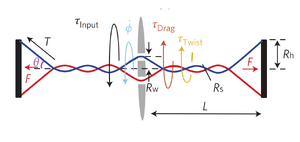
Three forms of torque dictate the motion of a paperfuge: torque generated by the user pulling the string ([math]\displaystyle{ \tau }[/math]input), torque due to air resistance ([math]\displaystyle{ \tau }[/math]drag), and torque generated by supercoiling of the string ([math]\displaystyle{ \tau }[/math]twist).[1]
Input Torque
The input torque is dependent on the force provided by the user as well as the angle made between the string and the handles, which is in turn dependent on the angular displacement of the paperfuge. [math]\displaystyle{ \mathrm\tau_{Input}(\phi) = -sgn(\phi)2R_sF\frac{|\phi|R_s+R_h+R_w}{\sqrt{L^2-(|\phi|R_s+R_h+R_w)^2}} }[/math]
where,
- [math]\displaystyle{ \phi }[/math] is the angular displacement
- [math]\displaystyle{ R_s }[/math] is the string radius
- [math]\displaystyle{ R_h }[/math] is the handle radius
- [math]\displaystyle{ R_w }[/math] is the distance from the holes to the disc center
- [math]\displaystyle{ R_d }[/math] is the disc radius
- [math]\displaystyle{ F }[/math] is the force applied by pulling
- [math]\displaystyle{ L }[/math] is the distance from the end of the string to the disc
Drag
As the paperfuge spins faster, the resulting air friction on the paper disc increases.
[math]\displaystyle{ \mathrm\tau_{Drag}(\dot{\phi}) = -sgn(\dot{\phi})a_R(\frac{4 \pi}{5}+2 \pi R_d^4) \dot{\phi}^2 }[/math]
where,
- [math]\displaystyle{ \dot{\phi} }[/math] is the angular velocity
- [math]\displaystyle{ a_R }[/math] is the air friction parameter
Twist Torque
As the string is wound past a certain point, it adopts a three-dimensional helical structure known as supercoiling. The equation for twist torque relies on the assumption that when the string starts to supercoil, its behavior can described as a linear spring force.
[math]\displaystyle{ \tau_{Twist}=-sgn(\phi)\frac{1}{\gamma}(\phi_{max}-\phi_{crit})^{\gamma+1}[\frac{1}{(\phi_{max}-|\phi|)^\gamma}-\frac{1}{\phi_{max}^\gamma}] }[/math]
where,
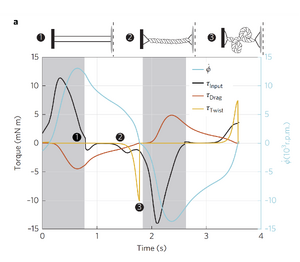
- [math]\displaystyle{ \gamma }[/math] is an empirically defined twisting parameter
- [math]\displaystyle{ \phi_{crit} }[/math] is the critical point of rotation at which supercoiling begins
- [math]\displaystyle{ \phi_{max} }[/math] is the maximum angular displacement, which cannot be exceeded
Energy Balance
Substituting the above equations into an energy balance describes the overall contributions of each torque while the paperfuge spins.
[math]\displaystyle{ \mathrm{I \ddot{\phi}} = \tau_{Input}(\phi) + \tau_{Drag}(\ddot{\phi}) + \tau_{Twist}(\phi) }[/math]
where,
- [math]\displaystyle{ I }[/math] is the moment of inertia
- [math]\displaystyle{ \ddot{\phi} }[/math] is the angular acceleration
When the paperfuge is completely unwound (Figure 1, frame 1), angular velocity is at a maximum, meaning [math]\displaystyle{ \tau_{drag} }[/math] is also at maximum. As the disc continues to wind, it reaches a critical displacement, [math]\displaystyle{ \phi_{crit} }[/math] (frame 2). The string supercoils, causing [math]\displaystyle{ \tau_{twist} }[/math] to spike and rapidly decelerate the disc to a stop (frame 3). From here, [math]\displaystyle{ \tau_{input} }[/math] dominates to spin the paperfuge in the other direction, repeating the cycle.
Bhamla, et al. used a high-speed camera filming at 6,000 frames per second to quantify the speed of the paperfuge. Video 1 shows the paperfuge in use. The unwinding phase occurs when the hands are pulled apart, allowing the paper fuge to reach its maximum rotational speed. Then, the disc's rotational inertia winds the string until it achieves supercoiling. Supercoiling drives the rapid acceleration of the disc, which reaches 125,000 RPM.
Point of Care (POC) Testing
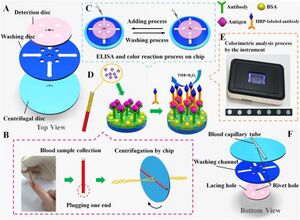
In resource-poor parts of the world, expensive electric commercial centrifuges are impractical for diagnostics. Commercial centrifuges also require training and auxiliary equipment, further hindering their usefulness in remote and rural areas. The paperfuge is a simple yet powerful alternative for rapid POC testing.[5] Prakash and his team used the paperfuge with quantitative buffy coat (QBC) analysis, a method which detects malaria in separated blood via fluorescence. They were able to detect the presence of disease-causing Plasmodium falcipuram after 15 minutes of centrifugation.[1] Bowei Li et al. expanded on the paperfuge to create a fully integrated enzyme-linked immunosorbent assay (ELISA) diagnostic system for detecting cancer-associated antigens. The three-layered disc consisted of a paperfuge for separating blood plasma, a detection layer for analysis, and a washing layer for removing unreacted reagents and antibodies during ELISA. The device cost 0.5 USD to manufacture, weighed 23.2 grams, and could detect tumor-related proteins including carcinoembryonic antigens (CEA) and alpha fetoproteins (AFP) in plasma after 4.5 minutes of centrifugation.[2]
Environmental Monitoring
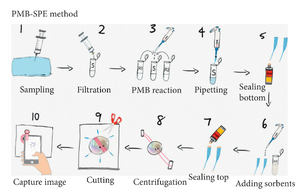
Paperfuges have also been used in field research for environmental studies, such as water quality. Zhen Pan et al. used a paperfuge to measure phosphate levels in environmental water, a key indicator for the health of aquatic plants. The phosphomolybdenum blue (PMB) method detects phosphate in water by creating a blue solid extract upon reaction with phosphate. The paperfuge design consisted of pipettes arranged with the tips facing on the outside of the disc. After sampled water was treated with the PMB method, the samples were loaded into the pipettes and centrifugated in the paperfuge for 30 seconds to isolate the precipitate to the bottom. The pipette tips were observed via camera lens to detect phosphate concentrations as low as 0.19 μM.[3]
References
1. Bhalma, M. S., Benson, B., Chai, C., Katsikis, G., Johri, A., Prakash, M. Hand-powered ultralow-cost paper centrifuge. Nature Biomedical Engineering. 2017, 1 (9). DOI: https://doi.org/10.1038/s41551-016-0009
2. Li, B., Qi, J., Fu, L., Han, J., Choo, J., deMello, A. J., Lin, B., Chen, L. Integrated hand-powered centrifugation and paper-based diagnosis with blood-in/answer-out capabilities. Biosensors and Bioelectronics. 2020, 165. DOI: https://doi.org/10.1016/j.bios.2020.112282
3. Pan, Z., Nong X., Xie, Y., Zeng, H., Liang, Y., Zhang, M. Field Determination of Phosphate in Environmental Water by Using a Hand-Powered Paper Centrifuge for Preconcentration and Digital Image Colorimetric Sensing. Journal of Analytical Methods in Chemistry. 2022. DOI: https://doi.org/10.1155/2022/7359197
4. This Simple Paper Centrifuge Could Revolutionize Global Health | WIRED. WIRED. YouTube, January 10, 2017. https://www.youtube.com/watch?v=L5ppD07DMKQ
5. Raju, S. P. and Chu, X. Rapid Low-Cost Microfluidic Detection in Point of Care Diagnostics. Mobile and Wireless Health. 2018, 42. DOI: https://doi.org/10.1007/s10916-018-1043-1
6. Yang, S., Lv, S., Zhang, W., Cue, Y. Microfluidic Point-of-Care (POC) Devices in Early Diagnosis: A Review of Opportunities and Challenges. Sensors. 2022, 22 (4). DOI: https://doi.org/10.3390/s22041620
